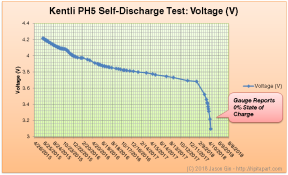Looking for the teardown or how well the Kentli PH5 battery performs under load? Click the links to learn more.
It’s finally happened – the self-discharge test of the Kentli PH5 Li-ion AA battery has finally come to an end… and it only took almost 3 years!

Kentli PH5 self-discharge test statistics
Self-Discharge Rate
I never anticipated this test would run for so long; although the PH5 did not have a manufacturer-specified self-discharge rate, marketing materials suggested that the batteries had a storage life that was “3-5 times longer than Ni-MH batteries”. Wikipedia states that after one year, normal Ni-MH batteries lose about 50% of their capacity, and low-self-discharge (LSD) Ni-MH batteries lose 15-30%.
Correlating this with the data collected from the Texas Instruments bq27621-G1 fuel gauge, the battery lost 40% of its charge within one year, placing it in between the standard and LSD Ni-MH chemistries. Using Excel’s SLOPE() function, the self-discharge rate was calculated to be 0.10108%/day.
Experimental Improvements
There is some error in State of Charge measurement when using the bq27621 fuel gauge. As it uses the Impedance Track algorithm, open-circuit voltage is used to determine a battery’s state of charge upon gauge initialization. This OCV curve is chemistry-specific, with slightly different formulations requiring different chemistry ID codes. The bq27621 has a fixed Chemistry ID of 0x1202 (LiCoO2/LCO cathode, carbon anode), but experimental data revealed a better-matched Chemistry ID of 0x3107, 0x1224 or 0x0380; the first two chemistries pointed towards a LiMnO4/LMO cathode chemistry which I was somewhat skeptical of, but did not test further.
Using another gauge with a different, programmable Chemistry ID could have led to a straighter SoC curve. This wouldn’t be too difficult to reproduce, as the battery voltage can be fed to the gauge in order to recompute the state of charge. Additionally, the bq27621 has a Terminate Voltage of 3.2 volts (the gauge considers this voltage to be the point in which it reads 0% SoC), which is higher than the battery’s protection voltage of 2.4 volts (granted, there is very little charge difference in this area of the discharge curve).
My test setup was not temperature-controlled; I live in a house without air conditioning and room temperatures can vary from 15 to 35 degrees C (59 to 95 degrees F), depending on the season. However, I doubt that this would have had too much impact on discharge rate, and this would better represent real-life scenarios where a constant temperature may not necessarily be guaranteed.
Finally, this test was performed on a new, uncycled battery. I suspect the discharge rate would be significantly higher on an aged battery that was subject to a lot of charge cycles and day-to-day wear.
Conclusion
This was the longest-running experiment I’ve ever conducted on this blog. The Kentli PH5’s self-discharge rate lasts longer than a standard Ni-MH battery, but a LSD (low-self-discharge) Ni-MH battery would still last longer, albeit with a lower terminal voltage. The battery, when new, should be expected to last almost 3 years without a charge (although there won’t be any charge left by then); it will hold about 60% of its capacity after 1 year of storage.
To download a copy of the self-discharge test data, click here.


Pingback: Teardown of Kentli PH5 1.5 V Li-Ion AA battery | Rip It Apart – Jason's electronics blog-thingy
Pingback: Performance analysis/review of Kentli PH5 Li-ion 1.5V AA battery | Rip It Apart – Jason's electronics blog-thingy
wow.
shady practice to say they last 3-5x longer on the shelf. I suppose that could be true for certain specialty devices that require closer to 1.5 volts. bad practice.
LikeLike
Thanks for this long-running experiment, comes useful to me.
I would like to switch to li-ion with my AA and AAA batteries because I have a fair amount of trouble with my ni-mh batteries.
The measured self-discharge rate is good enough for my general-purpose usage so this strengthens my resolve to switch to li-ion rechargable AA/AAA.
LikeLike
Do you know what is the difference between different 1.5v aa Li-ion rechargeables that are on the market now (Kentli, Jugee, Amptorrent, Blackcube, EBL, etc)? Are some of them identical?
LikeLike
I haven’t kept up with the newer rechargeables on the market, unfortunately.
LikeLike
There is one other big advantage that these batteries have – they don’t leak any electrolyte. I have had many of my battery powered devices damaged in the past because these alkaline batteries leak, don’t believe wat the manufacturer tells you (“leak proof” my a**, because they are NOT). Especially in low-drain devices this is a problem, because the alkalines will already have begun to leak while the voltage is still high enough to keep the device going (like TV remotes, wireless mice, keyboard), so you won’t notice the leakage until it is too late. Because when you finally replace the alkalines when the device actually quits working, the internal corrosion damage can be quite extensive.
I even had alkalines leak while in storage: Never used, and they still turn into a mess. I was completely done with that, and these 1.5V lithium-ion batteries solve that leakage problem for me. Worth the extra money.
LikeLike